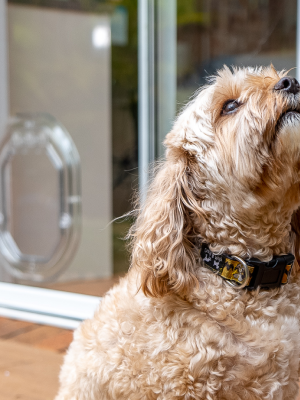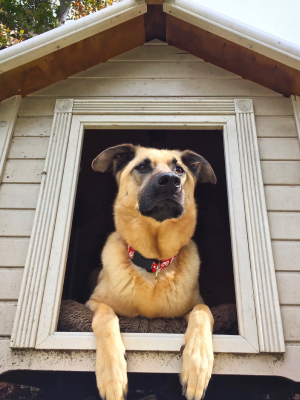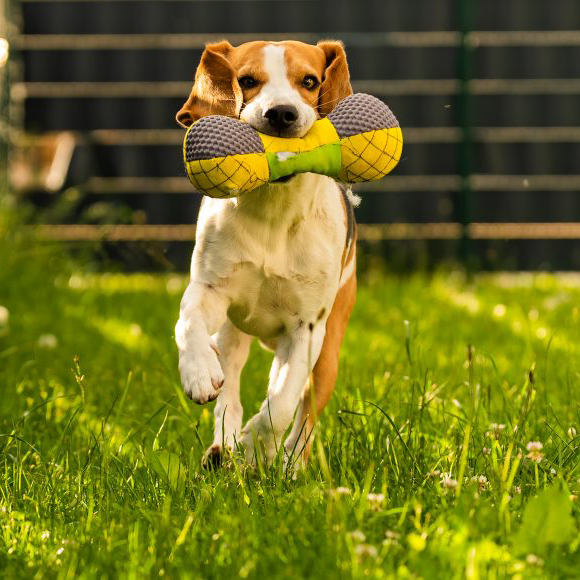
New pet owners are often faced with conflicting advice about whether or not it is cruel to keep a dog outdoors. Dogs are social animals who need plenty of interaction and appropriate shelter.
Our Blog
Our Blog
19/8/20
Is It Cruel To Keep My Dog Outdoors?
New pet owners are often faced with conflicting advice about whether or not it is cruel to keep a dog outdoors. Dogs are social animals who need plenty of interaction and appropriate shelter. While most dogs enjoy spending time playing outside, no dog should live it’s whole life confined outside to the yard. Along with physical exercise and good nutrition, a safe environment is one of the most important things to consider for the health and well-being of a new family pet. The happiest dogs are those who live as part of the family with time spent both indoors and out.
Keeping Your Dog Safe Outside
If your pet will be spending time outdoors, it’s important to make sure your yard is safe for your dog. Check to be sure it’s free from poisonous plants and that your dog can’t get access to any pool or garden sheds with chemicals. It should also be safely fenced to ensure other animals can’t get into the yard. Ideally, your dog should have separate sleep and play areas.
All dogs need a safe location with shelter to shade them from the sun and protect from the wind and rain. Even in Australia with our relatively mild winters, a cold wind and wet weather puts a dog at risk of hypothermia. If left alone, outside dogs can be frightened by storms or extreme weather conditions and jump the fence while looking for somewhere safe to shelter. If your dog likes to spend time outdoors, make sure they have free access to an insulated dog house, or can come and go inside via a doggie door into the house.
While it’s not cruel to keep a pet outdoors in mild weather, dogs are pack animals who thrive with companionship and being close to their owners. So it’s only natural that they will be happiest spending time with the family. A dog kept solely outside experiences social isolation and may bark or howl out of loneliness. Responsible pet ownership means finding a good balance between how much time a dog should spend outside for exercise and time spent indoors with you.
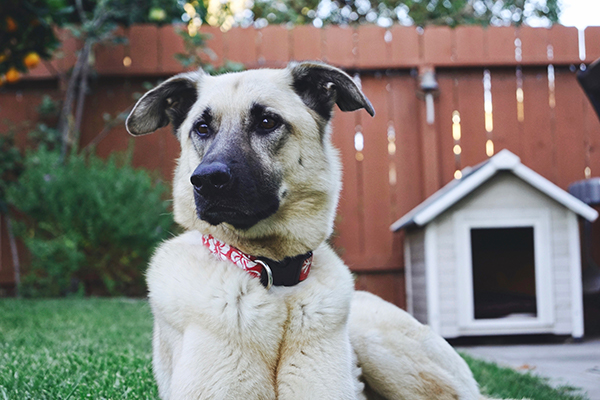
Are Dogs Happier Indoors or Outdoors?
Dogs need access to the outdoors for at least a few hours each day: for exercise and for their mental well-being. Taking your dog for a daily walk or spending time in the back yard or at the park is a great way to bond while also getting some exercise. Even old dogs that are no longer interested in long walks benefit from the stimuli of outdoor sights, sounds, and smells.
Dogs are happier when they can spend time with their humans and also get outside for some fresh air when the mood takes them. Bad weather is one reason to limit time outdoors. During the cooler months it can be hard to know if it’s better for dogs to sleep inside or outside. Most dogs are safer kept inside in winter, especially overnight. If you have a small breed dog, it’s probably not a problem if he curls up to sleep on your bed. But owners of large dogs might not feel as generous! This can especially be the case if there’s more than one dog vying for space in the master bedroom.
If having your dog locked inside overnight isn’t going to work for your family, a doggie door might be the answer. A cosy, draft free outdoor dog house with plenty of blankets will provide a comfortable place to sleep. A pet door with access to a second bed indoors in case of bad weather will give you peace of mind and help keep your dog safe and comfortable. If it’s too cold for your dog to sleep outside at night and you don’t want to share your bed, a heated pet bed or self-heating pad might offer your dog an inexpensive and appealing alternative.
Should Dogs Be Left Outside During Winter
Deciding if it’s a good idea to leave your dog outside while you are at work will depend on local weather conditions and your dog’s temperament. While Sydney’s Eastern suburbs and the Central Coast tend to have milder weather, temperatures around Western Sydney, Penrith, and the Blue Mountains regularly drop below safe temperatures for dogs to be left outside.
If you live in a cold or windy region, or have an exposed yard, it would be cruel to leave your dog outside when you are not home. But confining a dog inside with no one to play with can lead to boredom, destructive behaviour, and accidents on the carpet. Dog doors give your pet the option to come inside out of the cold, but also go outside when needed.
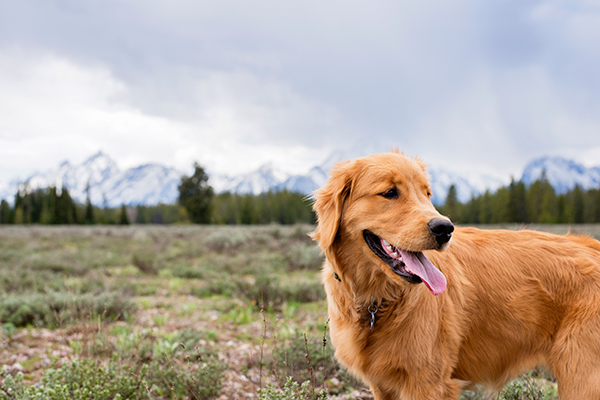
What Is A Safe Outdoor Temperature For Dogs?
As winter is truly upon us, it’s important for new pet owners to consider how safe their dog will be outside. While dogs handle the heat and cold differently to humans, generally speaking, if it’s too hot or cold for you to be comfortable outside, there’s a good chance your pet would be more comfortable inside as well.
The safe outdoor temperature range for dogs depends on a number of variables. Different breeds will respond to the cold in different ways. But even large-breed dogs that are adapted to the cold with a thick coat will still feel miserable if left outside in rain or cold weather with a low wind-chill factor.
Size
Small dogs suffer in the cold more than large dogs. Their thinner muscle layer, and greater skin surface area to body volume ratio means they lose body heat more easily. That’s why you’ll often see inside dogs like Toy Terriers and Chihuahuas snuggled up in a blanket. Small companion dogs are most at risk in temperature extremes and it would be cruel to leave them outside at temperatures below 10°C or above 30°C. Larger breeds are often okay to stay outside when the temperature goes as low as 7°C as long as there’s no wind.
Coat Type
Dogs with thick, layered coats are the most cold-tolerant. Breeds like Huskies, Maremmas, and Newfoundlands are the best dogs for cold climates. They can be outside in temperatures as low as 4°C with access to draft-free shelter. Thin coated dogs like Greyhounds are particularly vulnerable to the weather and should not be left outside in cold weather below 10°C.
Coat Colour
In direct sunlight, dogs with dark coats will absorb more heat from the sun than those with lighter coloured coats. On a clear winter’s day, this is often enough to give them a little extra protection from the cold, as long as they are out of the wind.
Age and Health
Younger puppies, old dogs, and dogs with health conditions are not able to regulate body temperature as well as healthy dogs in their prime. If your dog is getting older, it’s time to think about ways to make their environment more comfortable. For dogs who suffer from arthritis, their symptoms may become more apparent in cold weather making them feel sore and stiff. In this case it’s essential that your dog be able to seek shelter inside where it’s warm.
Cold Weather Dog Safety
In addition to individual dog breed and condition, the length of time to safely leave your dog outside will depend on what weather protection you provide. There’s nothing wrong with letting a healthy, active dog play outside in the cold if they are able to come inside to get warm. If your small breed dog is particularly active and is happier having outside access to play and run around, it would be unfair to confine them to the house.
Once the temperature drops below 10°C, it’s a good idea to look at ways to protect your dog from the winter chill when they are outside. An insulated dog coat or fleece warmie will help your smaller breed dogs stay warm. Larger breeds might benefit more from an oilskin dog coat that protects from the rain. Dog booties can also help if your outdoor area gets snow or morning frosts.
For owners of small breed dogs, dogs with thin coats, senior or sick dogs, a storm or sudden cold snap could pose a serious risk to your dog’s health. Even with a coat, prolonged exposure to cold temperatures will put your pet in danger of hypothermia and frostbite.
Hypothermia In Dogs
Even in Australia, dogs run the risk of hypothermia in winter when owners don’t know how to tell if it’s too cold for their dogs outside. Use your common sense. If you’re not sure if your dog will be okay outside, bring them in! Installing a dog door lets your dog decide for themselves if it’s too cold outside.
If your dog has been caught outside in bad weather, it’s important to keep an eye out for signs of hypothermia. Early symptoms of hypothermia in dogs include:
- Shivering
- Tiredness
- Slow, shallow breathing
- Weak pulse
- Muscle stiffness
- Fixed, dilated pupils
If you take your dog’s temperature, keep in mind that a dog’s normal body temperature range is between 38.3 and 39.2°C, slightly higher than for humans. Your dog is considered to be hypothermic if his core body temperature is below 37°C. If you suspect hypothermia, bundle your dog up with hot water bottles or warmed towels from the clothes dryer and contact a vet immediately.
Looking After Your Dog
If you don’t like the idea of your pet being locked outside for any length of time, especially in winter, having a pet door installed in your home is a great solution. Dog doors can be installed in almost all existing wood, glass, or security screen doors or windows. If you’re renting, there are non-permanent pet door options that are affordable and easy to remove.
Installing a pet door gives you the best of both worlds. It means your inside dogs can stay safe and warm, but still take themselves outside to go to the toilet or for some play time. And it means your outdoor dogs can seek shelter if the cold weather becomes uncomfortable.
Welcoming a new pet into your home means providing them with a safe and loving environment, and doing your best to meet their physical and social needs. You’ll develop a stronger bond with your dog the more time you spend together. A busy work or school schedule might not leave you with too many spare hours to play outside before it gets dark and cold, so inviting your pet into your home makes it easier to get some quality bonding time in. If you want your dog to grow up as part of the family, everyone will be much happier being free to spend time playing and relaxing together indoors and out.
For more information about pet doors and installation options for your home, give Sydney Pet Doors a call or send us an email. Our experienced team can help you choose the best pet door for your dog depending on breed size, budget, and your door or window configuration.
Latest Posts
Latest Posts
Questions? We’re here to help.

